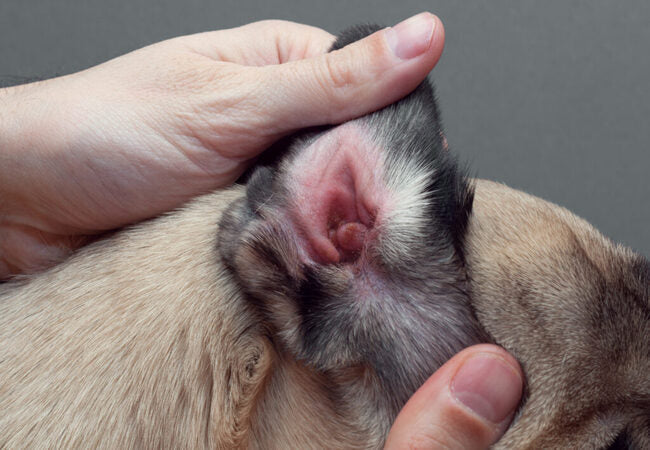🩺 Vet’s 2025 Comprehensive Guide to Canine Skin Ulcers 🐾

In this article
Vet’s 2025 Guide to Canine Skin Ulcers 🩺 Diagnosis, Care & Healing Strategies
By Dr. Duncan Houston BVSc
💡 What Are Skin Ulcers?
Skin ulcers are deep, open wounds where the top layers of the skin are lost, exposing raw tissue that can bleed or ooze fluid. These lesions are often painful, inflamed, and prone to infection.
🚩 Common Causes & Risk Factors
- 🔨 Pressure sores over bony areas or joints—especially in immobile dogs.
- ✂️ Trauma, bites, burns, or self-trauma from licking or chewing (lick granuloma).
- 🦠 Infections—bacterial, fungal or parasitic—often complicate ulcers.
- ⚕️ Autoimmune conditions like cutaneous lupus or vasculitis.
- 🚫 Neoplasia—tumors (mast cell, squamous cell carcinoma) may ulcerate.
- 🔧 Circulatory issues, endocrine disorders (e.g., Cushing's), or nutritional deficiencies.
👀 Clinical Presentation
- 🔴 Wet or dry ulcerated lesion—bleeding, crusting, or oozing.
- 🔥 Painful to touch, swollen, smelly if infected.
- 🛌 Often located at pressure points, wounds, or licking sites (e.g., legs, elbows).
- 🐾 Hair loss and surrounding redness; scabs or necrotic tissue may be present.
🧪 Diagnostic Evaluation
- History & Physical: onset, behaviors (licking, chewing), medication history.
- Cytology & Culture: impression smears or swabs to detect bacteria, fungi.
- Skin Scraping: rule out demodex or sarcoptic mange.
- Biopsy: essential for ulcers suspected from autoimmune disease or tumors.
- Bloodwork & Imaging: CBC/chemistry, endocrine tests, imaging for deeper disease.
🛠 Treatment Approach
1. Wound Care & Debridement
- 🧼 Clean with sterile saline or chlorhexidine; remove dead tissue gently.
- 🩹 Use appropriate dressings—hydrogel, foam—for moist healing.
- 🛋️ Off-load pressure: soft bedding, padded supports, protect feet/elbows.
2. Control Infection
- 💊 Oral antibiotics or antifungals based on culture; long courses (weeks to months) may be needed.
- 🧴 Topical antimicrobials to decrease bacterial colonization.
3. Address Underlying Cause
- ✋ Lick granulomas: use Elizabethan collars, behavioral redirection.
- 🛡 Autoimmune ulcers: use immunosuppressives (prednisone, cyclosporine).
- 🔧 Treat endocrine issues; correct nutrition and wound-promoting deficiencies.
- ✂️ Surgically excise ulcerated tumors when present.
4. Pain Relief & Comfort
- 💊 Provide NSAIDs or pain relief as prescribed.
- 🛏 Comfort measures: soft beds, avoid trauma; environmental enrichment to reduce licking.
5. Prevent Recurrence
- ⬇️ Off-load pressure—soft bedding, frequent repositioning for immobile dogs.
- 📆 Long-term monitoring and supportive care to catch and treat recurrences early.
📈 Prognosis & Follow-up
- 🕒 Healing time varies from weeks to months depending on cause and care.
- 🔁 Chronic ulcers may recur without addressing underlying issues or proper wound management.
- ⚠️ Prognosis worsens if underlying disease (e.g., cancer, autoimmune, endocrine) remains unresolved.
🏡 Ask A Vet App Support Tools 📲🐶
- 📆 Treatment reminders for wound care, meds, rechecks.
- 📸 Photo diary of ulcer progression and healing.
- 📊 Track pain, licking, swelling, odor.
- 🔔 Alerts when signs worsen—prompt veterinary review.
- 📚 In-app guides: cleaning steps, dressing types, pressure point relief methods.
🔑 Key Takeaways ✅
- 🩸 Skin ulcers signal deep tissue loss—urgent evaluation needed.
- 🔍 Diagnosis includes cytology, culture, biopsy, and labs/imaging.
- 🛠 Proper wound care + control infection + address underlying cause = best outcome.
- 🛏 Preventive care (pressure relief, behavior modification) reduces recurrence.
- 📱 Ask A Vet app empowers owners with tracking, reminders & digital vet partnership.
🩺 Final Thoughts ❤️
In 2025, treatment of canine skin ulcers relies on a combination of astute diagnosis, meticulous wound care, and managing root causes—whether pressure, infection, autoimmune disease, cancer, or self-trauma. With comprehensive home care, veterinary-guided therapies, and owner engagement through tools like Ask A Vet, most dogs can heal fully and regain comfort. Monitoring and prevention are essential—first intervention is key. 🐾✨
Visit AskAVet.com and download the Ask A Vet app to log wound care, meds, photos, alerts, and maintain seamless contact with your veterinary team anytime. 📲🐶






